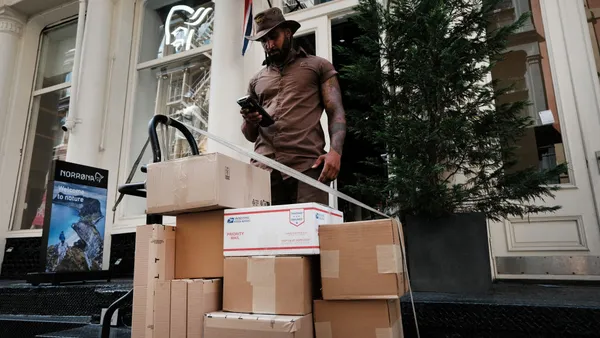Dive Brief:
- Holiday shoppers have four primary delivery concerns, but late-arriving packages top the list for 4 out of 10 online shoppers, according to a survey of 2,550 shoppers conducted by Convey.
- While 64% of respondents cite costs as the most important shipping factor this year, 62% cited costs last year. The larger and more concerning increase is in shoppers saying 1- or 2- day delivery, decreed by Amazon as a customer expectation, is a key factor. That number jumped from 11% last year to 19% this year.
- There are six takeaways in The Last Mile Delivery Wars: How to keep your promises and win with reliability. They revolve around dependable internal and external communication as well as data analysis to identify pain points. The report also suggests listening and responding to customer feedback.
Dive Insight:
Last-mile delivery wars are front and center during peak season, but the battle can be lost at any point during the year when customer expectations are not met.
The retailer bears the brunt of a poor customer experience. A bad delivery experience will push 83% to shop elsewhere, according to Convey's survey. This is a sobering fact for all companies competing for the just-under-70% chunk of the market that is not going to Amazon during the holidays.
The biggest obstacle to meeting delivery promises are costs. Faster comes with a price. Has Amazon figured it out? Depends.
Amazon is spending more to meet tight delivery windows and that impacts margins. Amazon is absorbing the smaller margins, but where it is winning is in setting the bar (that few can meet) for customer expectations and price. Walmart and Target followed Amazon's steps.
Outspending Amazon is not an option for most businesses. A better strategy is to involve the tech side to collect and analyze data and take that information to revamp or streamline processes, Convey noted. Avoid trying to make good on a botched delivery. Make it right from the start.
About 80% of shoppers purchased at least 10% of their products online this year. That represents 31% growth from last year. And it represents an opportunity for shippers. Deliver on expectations, no matter how slow or fast; that's how to compete.
Shoppers in the survey say they are willing to make tradeoffs, but they come at the expense of the seller. If delivery is free, 65% say they are open to slower delivery. Almost 10% say discounts on a future purchase is also a reason to forego faster delivery. Something to pay attention to is the 5% that say nothing will make them accept slower delivery.
With an expected $645 billion value on e-commerce next year, last-mile delivery reliability can make the difference between losing out to Amazon's free and speedy shipping options and being competitive.















